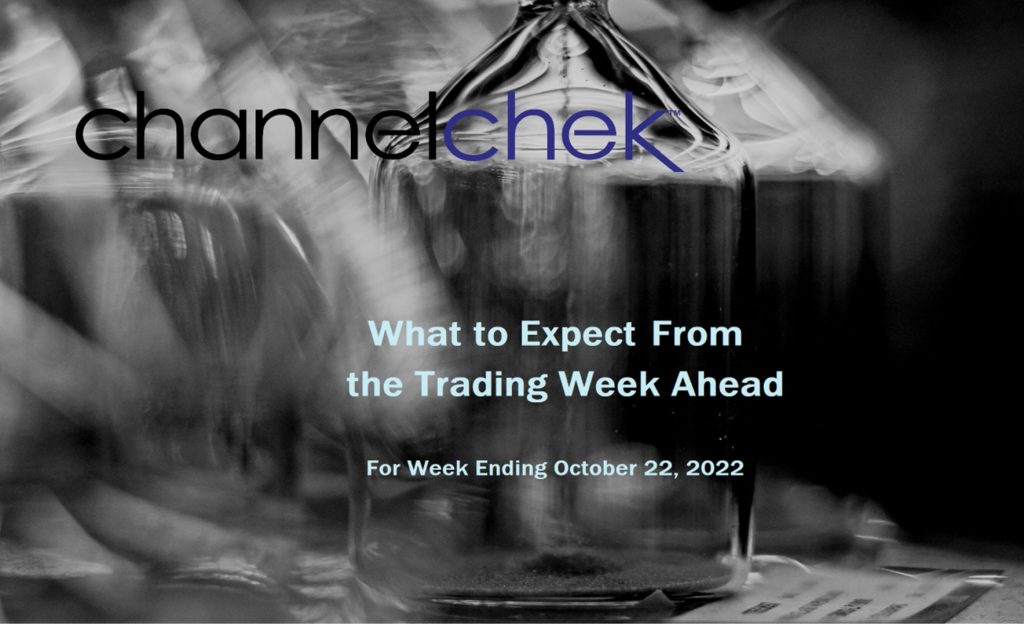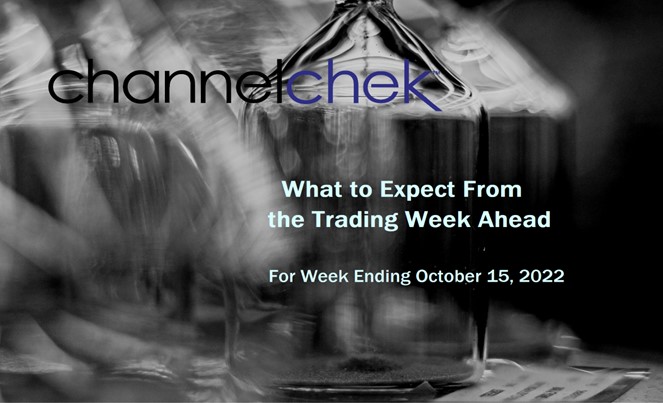
Could This Week’s Economic Data Impact November’s FOMC Meeting?
There are three economic releases investors will focus on this coming week. These will provide information on housing, manufacturing, and how the economy in each Federal Reserve District is doing (Fed’s Beige Book).
Moving out a little further on the calendar, expectations for another 75 basis point rate hike at the November 1-2 FOMC meeting are widely held. The confidence in the Fed move, even though two weeks away, can be attributed to higher-than-expected inflation reports last week and the constant pounding of the drum by Fed policymakers, saying that taming inflation will remain the FOMC’s priority.
What’s on Tap for investors:
Monday 10/17
- 8:30 AM Empire State Manufacturing Index, will be reported. Expectations are for manufacturing to have shrank -2.5%. The Empire Manufacturing Survey gives a detailed look at how busy New York state’s manufacturing sector has been and where things are headed. Since manufacturing is a major sector of the economy, this report has a big influence on the markets. Some of the Empire State Survey sub-indexes also provide insight into commodity prices and inflation. The bond market can be sensitive to the inflation ramifications of this report. The stock market pays attention because it is the first clue on the U.S. manufacturing sector, ahead of the Philadelphia Fed’s business outlook survey.
- 8:45 Noble Capital Markets’ Michael Kupinski, Director of Research, provides indepth report on current state and outlook of the Digital Media segment of the Media and Entertainment sector.
Tuesday 10/18
- 10:00 AM Housing Market Index will be released. Expectations are for the number to be 44, down from 46 the prior month. The housing market index has consistently been lower than expectations, including September’s 46, which was an 8-year low. N.Y. Fed 5-year inflation expectations for one- and three-year-ahead inflation expectations had posted steep declines in August, from 6.2 percent and 3.2 percent in July to 5.7 percent and 2.8 percent, respectively. Investors will be watching to see if the declining expectations continue. The housing market index is a monthly composite that tracks home builder assessments of present and future sales as well as buyer traffic. The index is a weighted average of separate diffusion indexes: present sales of new homes, sales of new homes expected in the next six months, and traffic of prospective buyers of new homes.
- 9:45 AM Industrial Production has three components that could impact thoughts on the economic trend. Industrial Production as a whole is expected to have risen 0.1% versus down -0.2% in the prior period. Manufacturing output is expected to have risen by 0.2%, and Capacity Utilization is expected to be unchanged at 80%.
Industrial production and capacity utilization indicate not only trends in the manufacturing sector but also whether resource utilization is strained enough to forebode inflation. Also, industrial production is an important measure of current output for the economy and helps to define turning points in the business cycle (start of recession and start of recovery).
- Comtech Telecommunications (CMTL) with Noble Capital Markets in NYC in-person roadshow for investors. Interested parties can find out more at this link.
Wednesday 10/19
- 7:00 AM Mortgage Applications. The composite index is expected to show a decline of -2.0% for the month. The purchase applications index measures applications at mortgage lenders. This is a leading indicator for single-family home sales and housing construction.
- 8:30 AM Housing Starts and Permits. The consensus for starts is 1.475 million (annualized), and Permits are expected to come in at 1.550 million (annualized). Housing starts to measure the initial construction of single-family and multi-family units on a monthly basis. Data on permits provide indications of future construction. A housing start is registered at the start of the construction of a new building intended primarily as a residential building.
- 2:00 PM, the Beige Book will be released. This report is produced roughly two weeks before the Federal Open Market Committee meeting. In it, each of the 12 Fed districts compiles anecdotal evidence on economic conditions from their districts. It is widely used in discussions at the FOMC monetary policy meetings where rate decisions are made.
- EIA Petroleum Status Report. The Energy Information Administration (EIA) provides weekly information on petroleum inventories in the U.S., whether produced here or abroad. The level of inventories helps determine prices for petroleum products, this has been a big focus for investors because of its implications for prices.
Thursday 10/20
- 8:30 AM Jobless Claims for the week ending 10/15. Claims are expected to be 235 thousand. Jobless claims allow a weekly look at the strength of the job market. The fewer people filing for unemployment benefits, the more they have jobs, and that sheds light for investors on the economy. Nearly every job comes with an income that gives a household spending power. Spending greases the wheels of the economy and keeps it growing.
- 8:30 AM Philadelphia Fed Manufacturing Index. This index has been bouncing back and forth between contraction and expansion. It’s the former that’s expected for October, where the consensus is minus 5.0.
- 10:00 AM Existing Home Sales. The consensus is for sales to have been 4.695 million (annualized). The previous number was 4.8 million. The pace has declined every month since January.
- 10:00 AM Leading Indicators. The consensus is for a decline of -0.3%. The index of leading economic indicators is a composite of 10 forward-looking components, including building permits, new factory orders, and unemployment claims. It attempts to predict general economic conditions six months out.
- Engine Gaming Media (GAME) with Noble Capital Markets in St. Louis in person roadshow for investors. Interested parties can find out more at this link.
- 10:30 AM EIA Natural Gas Report. This is a weekly report and has gotten much more attention since the war in Ukraine and gas pipeline issues that impact much of Europe. The abundance or lack of energy impacts prices not just for the consumer, but also manufacturers. This report has the ability to move markets as a result.
- 4:30 PM Fed Balance Sheet. The Fed’s balance sheet is a weekly report presenting a consolidated balance sheet for all 12 Reserve Banks that lists factors supplying reserves into the banking system and factors absorbing reserves from the system. This report will allow investors to see how far along the Federal Reserve has gotten on its quantitative tightening program.
Friday 10/21
- 1:00 PM Baker Hughes Rig Count. The expectation is for 985 in North America and 769 in the U.S. It’s all about potential supply; the count tracks weekly changes in the number of active operating oil & gas rigs. Rigs that are not active are not counted.
What Else
This week the Biden administration has plans to take new steps to lower gasoline prices. This includes potentially releasing more oil from the Strategic Petroleum Reserve and imposing limits on exports of energy products. The initiative comes a week after the Organization of the Petroleum Exporting Countries (OPEC) and its allies agreed to cut oil production by up to 2 million barrels per day.
Corporate earnings season starts to heat up with widely watched names that can set the market tone. Those to watch out for include: Monday – Bank of America, Charles Schwab, Goldman Sachs, Barclays, Johnson & Johnson, Lockheed Martin, IBM, Netflix, United Airlines, American Airlines, Procter & Gamble, and Tesla. Investors can also expect a key GDP release from China and a vital inflation reading from the U.K.
Managing Editor, Channelchek
Sources
https://www.investopedia.com/what-to-expect-for-the-markets-next-week-4584772



